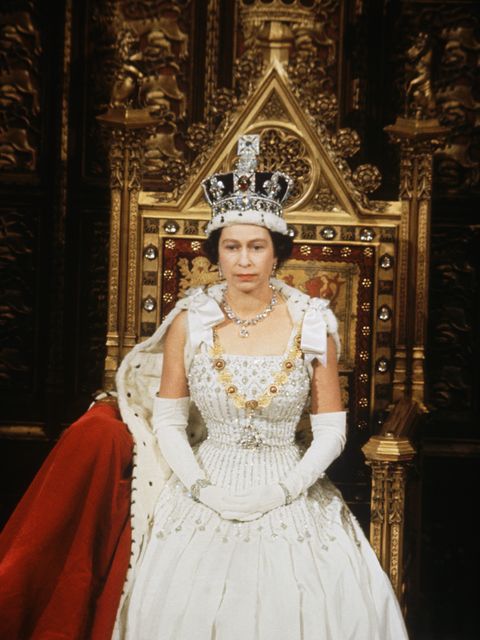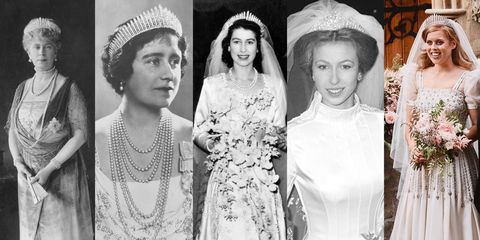
Photo Illustration: Mike Stillwell; Photos: Getty ImagesGetty Images
Can the wedding of Princess Beatrice to Edoardo Mapelli Mozzi, a decidedly intimate affair, actually be the most royal ceremony of them all? Jewelry experts have declared it so. And it just might be because of the tiara.
Expert and author historian (and must-follow Instagram user) Vincent Meylan wrote the history of the headpiece in a post on Sunday and prefaced it with this: “Princess Beatrice of York’s secret wedding at Windsor yesterday turned out to be more royal than them all.” And Fred Leighton’s creative director and expert Rebecca Selva texted me with enthusiasm and exclamation marks the second the images were released: “Could there have been a more perfectly beautiful—and royal—family wedding! This wedding was about family: celebrating love, honoring family and respecting tradition, with a great sensitivity to and awareness of the times we are living!”
The question then becomes, as Queen Elizabeth herself chose Queen Mary’s fringe tiara for her granddaughter, a bride forced to scale down her much anticipated nuptials due to a pandemic compounded by a looming family scandal—did her Majesty choose with these intentions? Did the Queen know a jewel with so much family history and provenance would signal solidarity and strength and endurance? Of course she did. How could she not?
Her namesake, the Virgin Queen herself, used pearls as power. See the legendary Armada portrait of Elizabeth I fresh from her victory over an invading Spanish Armada, portrayed in the portrait laden with the white pearls of wisdom and chastity. Pearls proved an effective and enduring signifier of her reign—she had proven victorious at sea and was draped in treasures from it.
And anyone who doubts the Queen’s clever use of jewelry to control the narrative might remember that royal power is bestowed and sealed with a collection of jewels. Almost every ritual in the anointment of a sovereign is marked with gold or precious stones: the Coronation Ring placed on the fourth finger by the Archbishop of Canterbury, the Sovereign’s Orb, and the Sceptre with the Cross.
The Orb—a gold sphere with diamonds, pearls, and other gemstones and topped with a golden cross, consecrates the role of Defender of the Faith. The Sceptre, symbolizing that the monarch has temporal authority under God, is set with the second largest diamond in the world. And at the end of the ceremony, the Imperial State Crown, a jewel whose historic stones contain multitudes is placed on the monarch’s head. It is jewelry, for lack of a better term, that seals the deal.
And we need not even go that far back. In early April, at the height of the pandemic, Queen Elizabeth came on screen to calm the world and reassure her public that they would indeed “meet again” while wearing a diamond and turquoise brooch that belonged to Queen Mary, who had seen the country and the King through the horrors of the First World War. Also note: in legend, turquoise been celebrated as a stone of healing and love and protection, worn for centuries as amulet and talisman, and thought to enhance powers of leadership. Her Majesty wears the emerald version of the Vladimir tiara on official visits to Ireland and a maple leaf brooch for Canada.
Like any grandmother, she wanted to make sure that though Princess Beatrice’s wedding might be diminished due to circumstances, the bride herself—in a vintage dress made for the Queen by couturier Norman Hartnell, the designer behind both Queen Elizabeth and Princess Margaret’s own wedding gowns— would not be. And she knew what a tiara could say to the world. The Queen Mary Fringe tiara began as a necklace given to Queen Mary by Queen Victoria—one of England’s most beloved Queens and one half of its most enduring and love filled marriages. Mary, as was her way, transformed it into a tiara and wore it often. She was stern, but strong.
And it was this woman’s legacy that Queen Elizabeth herself chose to Telegraph when she selected the Fringe to wear at her own wedding to Prince Philip in 1947. And yes it snapped the morning of (it was originally meant to be a necklace after all) but the crisis was averted and the monarchy carried on, as did this royal marriage. The Queen’s daughter Princess Anne also chose to wear it to her own wedding—a clear and direct line to the official love of her own parents. (Anne’s marriage to Captain Mark Phillips did not have the same luck, but no matter.)
And for Beatrice, on a wedding day that might have been small and where she might not have been surrounded by a royal court or heads of state, she still, thanks to her Grandmother, had a clearly established show of support, and a glittering connection to a series of enduring royal marriages, strong women, and survival, despite it all.
This content is created and maintained by a third party, and imported onto this page to help users provide their email addresses. You may be able to find more information about this and similar content at piano.io
This commenting section is created and maintained by a third party, and imported onto this page. You may be able to find more information on their web site.


